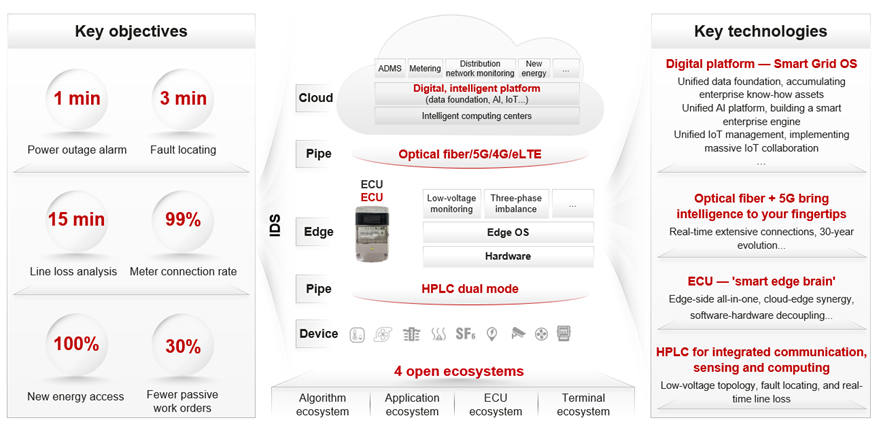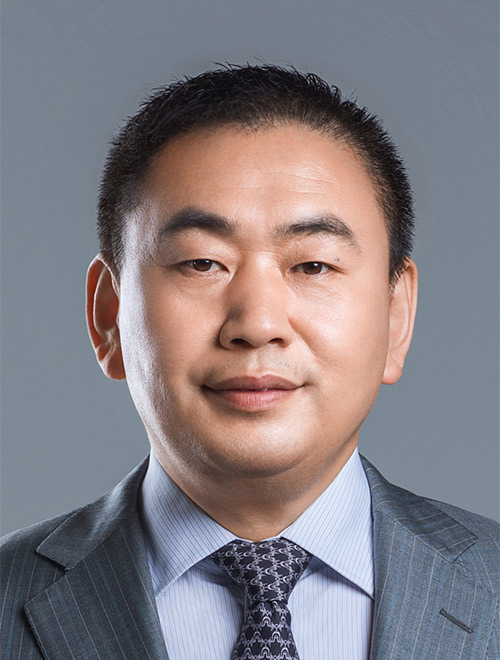Carbon neutrality and carbon peak strategies are driving the adoption of new energy worldwide. However, new energy is restricted by weather and climate, which means extreme weather conditions and unpredictable external environments bring an element of uncertainty to new energy sources.
The main challenge for future power systems lies in transitioning from load-based power generation in certain environments to source-grid-load-storage interaction in uncertain environments. To systematically maximize the value of digitalization and intelligence, we must consider the following.
First, integrating digitalization with electric power scenarios is the only way to address the systematic challenges faced by electric power systems. Huawei’s outlook on power scenarios may not be from an insider’s point of view, but our fresh perspective can still provide valuable reference and input for power companies.
We need to build grid-based sources, loads and networks. Grid-based sources, like weather forecasts, can provide accurate weather data to enhance the prediction accuracy of wind, solar, and hydro power generation. Grid-based loads involve the precise analysis and prediction of energy consumption behavior. Grid-based networks enable the accurate collection of network status information, such as low voltage, reverse voltage overload, three-phase imbalance, active and reactive power, and asset running status.
It is necessary to align these three grid-based capabilities with service strategies to achieve grid autonomy. For instance, in a transformer district, service strategies include traditional power consumption, distributed PV access, charging pile group management and control, energy storage interaction, and user interaction.
In addition, “brain” control needs to be efficiently linked to achieve grid autonomy. We also need to create space for market-oriented interaction. Market-oriented mechanisms support efficient and precise interaction on the demand side to achieve a balance between supply and demand. This includes participating in peak regulation according to user market behavior.
Second, power companies must build digital capabilities centered on digital foundation and open ecosystems to address the challenges of new power systems.
The digital foundation consists of three core capabilities: ubiquitous network connection, powerful intelligent computing, and a digital platform that accumulates enterprise know-how assets. These will become the new strategic assets of power enterprises.
In the digital era, no single player can solve all pain points. Hierarchical decoupling, modularization, and converged innovation are indispensable. Open, digital and intelligent ecosystems must be created, including for algorithms, applications, edge computing, and terminals.
These ecosystems will allow industry and cross-industry capabilities to be used by customers on demand.
By focusing on the fields that one excels at and starting from scenarios, we can create greater value for the industry. In March 2022, Huawei set up a dedicated team for the power industry — the Electric Power Digitalization BU. Its business scope covers R&D, marketing, sales, service, and ecosystem construction. Aiming to build a bridge between key power scenario requirements and digital technologies, the BU is committed to pairing digital and intelligent communication technologies to the right scenarios.
As we know, the core challenge facing new power systems lies in the power distribution network. In addition to improving power supply reliability and reducing line loss, future power systems also need to deal with challenges brought by new energy and new loads. In China, we worked with our partners to help State Grid Shaanxi build the Intelligent Distribution Solution (IDS).
 Introduction to Intelligent Distribution Solution (IDS)
Introduction to Intelligent Distribution Solution (IDS)
Huawei
We helped State Grid Shaanxi build a digital power distribution foundation featuring “cloud-pipe-edge-pipe-device” synergy, which enabled the company to evolve from the single-point digitalization of transformer districts and power distribution rooms to architecture-supported, evolvable, open, and systematic intelligence.
Four key technologies were deployed in the digital foundation.
First, the edge computing unit (ECU) integrated multiple terminals in the transformer district and now functions as the smart brain of the edge. Working with cloud-edge synergy, the ECU enables edge devices to be quickly upgraded online. The app store and cloud orchestration implemented the flexible deployment of various services at the edge. Different policies can be defined at each transformer district for flexible district autonomy. Through this, transformer district managers have become creative mini CEOs.
Second, optical fiber and wireless networks were deployed for backhaul. Building a highly reliable distribution backhaul communication network can be a huge challenge. We believe that the wireless private network is the optimal solution when wireless spectrum resources are available. Optical fibers can be deployed in cities and important areas to support the real-time access of multiple services. In wide-coverage areas, communication backhaul can be implemented through carrier public networks or wireless private networks.
The third was high-speed power line carrier communication (HPLC) dual-mode technology, which solved the problem of last-mile communication. HPLC can deliver 99.9% communication reliability, which supports minute-level data collection and second-level control for low-voltage transparency. It was the solution of choice to achieve an observable, measurable, adjustable, controllable and traceable low-voltage side.
The fourth was the cloud-based unified enterprise digital platform, which now acts as the smart OS. By building the enterprise-level unified data foundation, unified AI model factory, and unified IoT platform, State Grid Shaanxi can accumulate valuable know-how assets.
Huawei also helps customers build an open ecosystem. We are committed to eliminating industry barriers and making industry and cross-industry digital capabilities available to all industry players through integration and innovation.
At the Electric Power Digitalization BU, we strive to empower electric power experts with digital expertise and help customers build systematic digital capabilities for sustainable development.
Based on the digital foundation and the open ecosystem, State Grid Shaanxi implemented topological identification for the transformer, meter box and household meters at the low-voltage side.
In blind tests, the accuracy reached 100%, the daily frozen data collection success rate reached 99.98%, abnormal events were reported within one second, and power outages were notified within 3 minutes.
The solution can also deliver 15-minute transformer district line loss calculation and analysis, and supports 0.4 kV distributed PV group control and management as well as orderly charging. The customer’s operation model has changed from passive response to proactive service.
The number of annual passive work orders has been reduced by 35%, improving user satisfaction.
In addition to power distribution, we also offer intelligent power generation, transmission, and transformation solutions.
Huawei will continue to focus on the arenas of communications, digitalization, and AI that we excel in. In other areas such as applications, data, hardware, and integration services, Huawei will team up with industry companies and ecosystem partners to jointly solve problems and create value.
 Vice President of Huawei,
Vice President of Huawei,
CEO of Electric Power Digitalization Business Unit, Huawei
Huawei
More than 24 years of experience in the ICT industry. Mr. Sun has over two decades of experience in the ICT industry. He joined Huawei in 1998, and has taken on various roles during his time with the company, including President of the Southeast Asia Region, President of the Global Marketing and Solution Sales Dept of Carrier Network BG, Deputy Chief of Huawei Strategic Reserves, and Vice President (responsible for technology) of Enterprise BG,President of EBG Global Energy Business Unit. Member of Huawei’s transformation steering committee, member of the Standing Committee of the 11th Council of the China Electrical Engineering Society (CSEE), and director of the CEIA Energy Digitalization Profession Committee.
Over the past years, his work has involved many domains, such as regional market management, R&D, marketing, industry solution planning and design in and out of China. He had taken part in multiple key corporate transformation projects, accumulating extensive experience in new businesses, transformation, and cross-cultural team building.
>>> Read full article>>>
Copyright for syndicated content belongs to the linked Source : CIO – https://www.cio.com/article/2096062/leading-infrastructure-to-accelerate-electric-power-intelligence.html































